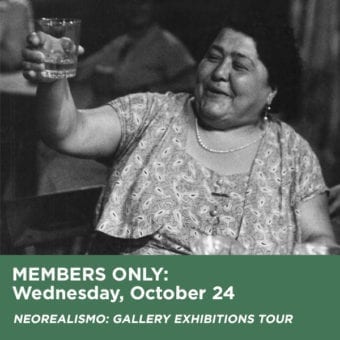Giorgio Morandi’s Fiori: a ‘minor’ genre?
December 11, 2018
Do not miss the unveiling of the latest addition to our Metaphysical Masterpieces 1916–1920: Morandi, Sironi, and Carrà exhibition and join us for a special evening dedicated to Giorgio Morandi series of flower paintings in view at CIMA!
Giorgio Morandi is known mostly for his still lives with objects, which constitute the fulcrum of his painterly practice. However, he also painted Fiori (Flowers). These became a central part of his production during the first decade of the 1900s, and are now exceptionally shown as a group at CIMA. Laura Mattioli traces the evolution of this theme in the context of the artist’s entire production.
Laura Mattioli is the Founder and President of the Center for Italian Modern Art (CIMA), as well as member of its Advisory Committee. As an art historian, curator, and collector, she specializes in twentieth century Italian art and has published, lectured, and presented extensively on the subject. Since 1983, Mattioli has been the curator responsible for the collection of her father, Gianni Mattioli. Considered one of the most important aggregations of Italian avant-garde and modern art, the collection has, under this stewardship, loaned works to institutions throughout the world, including the Peggy Guggenheim Collection in Venice.
MISSED THE TALK? VIEW IT HERE
$10; free for CIMA members and students!
Please note: CIMA will be live-streaming the program on our Facebook page.
Program schedule:
6pm – doors open; prosecco and viewing of Metaphysical Masterpieces
6:15pm – program begins, followed by audience Q&A
7:30pm – Evening concludes

Members Only: Andy Warhol’s ‘Shadows’ with Jessica Morgan and Neil Printz
December 04, 2018
CIMA Members are invited to join us for a private morning visit of Dia’s exhibition dedicated to Andy Warhol: Shadows at a specially built-out gallery space at Calvin Klein, Inc.’s headquarters at 205 West 39th Street.
Andy Warhol’s Shadows (1978–79), first presented by Dia in the city in 1979, is an environmentally scaled painting in multiple parts that encompass the viewers. It embodies Warhol’s increasing interest in abstraction in the late 1970s and synthesizes key elements of his practice, including film, painting, photography, and screen-printing.
Jessica Morgan (Nathalie de Gunzburg Director of Dia Art Foundation) and Neil Printz (Editor of The Andy Warhol Catalogue Raisonné) will lead this exclusive tour for CIMA members.
Please note: CIMA Members will receive a private invitation link to RSVP for this event. Limited to 20 members only!
Members receive free admission to CIMA, access outside of regular public hours, a copy of the annual catalogue, and invitations to exclusive events and receptions.

DRAWING NIGHT & APERITIVO AT CIMA
November 29, 2018
“A throw of the dice will never abolish chance,” wrote the poet Stéphane Mallarmé.
For CIMA’s last public program in November, Jen Mazza will lead a unique evening of drawing and conversation, addressing the artworks on view by Morandi, Sironi, and Carrà featured in the Metaphysical Masterpieces exhibition. Discussion will touch upon strategies of metaphor and image, chance, juxtaposition, and collage. Join us and see for yourself how the metaphysical can reimagine reality.
All skill levels welcome!
Limited to 30 participants.
$15; FREE for CIMA Members.
Event Schedule:
6pm – Registration and exhibition viewing
6:10pm – Introduction by Jen Mazza
6:30-7:30pm – Drawing in CIMA’s galleries
7:30pm – Discussion
8pm – Evening concludes
About the artist:
Jen Mazza (born 1972, Washington D.C.) is a New York based artist who works and teaches at the Parsons School of Design and the Pratt Institute. Her collaborative teaching integrates reading, artmaking, and research across a range of disciplines, often focusing on close visual analysis and problem-solving.
Her work engages with pre-existing images to develop, as Walter Benjamin writes in The Arcades Project, “the art of citing without quotation marks.” By allowing things to speak for themselves through the medium of paint, Mazza attempts to gently undermine habitual structures of seeing and understanding the action of making, drawing out what is overlooked in our relationship to images and objects.
Mazza received her B.A. in Visual Art and Spanish Literature from Mary Washington College in Fredericksburg, Virginia (1994), and an M.F.A. in Visual Art from Mason Gross School of the Arts at Rutgers University (2001). Her work has been reviewed in the New York Times, Art in America, Art News, Art 21 and Hyperallergic. She is represented by Tibor de Nagy in New York and a survey of her recent work, entitled “Disobedience is not careless”, is currently on view at the James Gallery of the Center for the Humanities at the Graduate Center.
*Please note that guests are allowed to bring their own supplies, but only sketching materials are permitted. No water media, ink, or solvents are allowed in the galleries.
Refreshments have been generously donated by:
Art supplies generously donated by:
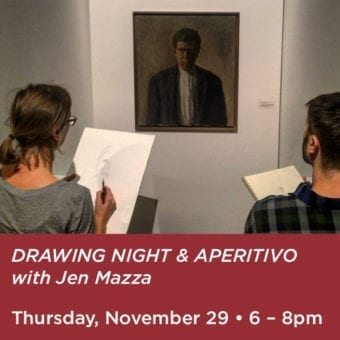
Metaphysics in Everyday Life
November 28, 2018
A conversation between Paul Stirton and Antonio David Fiore on interwar European decorative arts’ response to themes of Metaphysical painting.
This event aims to explore the way recurrent themes, iconography, and atmospheres of Metaphysical painting entered the repertoire of European decorators from the 1920s on. Antonio David Fiore will discuss works by Gio Ponti, Tomaso Buzzi, Piero Fornasetti, and Giulio Rosso. Focusing on their appropriation of aspects of de Chirico, Carrà, Sironi, and Morandi’s art, Antonio will show how Metaphysical painting—a complex approach to art, rooted in philosophy and literature—was turned into a source of suggestive decorative motives. Once deprived of their most unsettling and disquieting atmospheres, these themes became part of the taste of the time, not only in Italy but also in other countries. Paul Stirton will respond by showing examples from central Europe, in which parallel approaches can be detected. Stimulating comparisons between different contexts will emerge, as well as a different perspective from which to look at the Metaphysical Masterpieces exhibition on view in CIMA’s galleries.
MISSED THE PROGRAM? WATCH THE VIDEO HERE
Please note: CIMA will be live-streaming the program on our Facebook page.
Program schedule:
6pm: Viewing of Metaphysical Masterpieces
6:15pm: Program begins, followed by audience Q&A
8pm: Evening concludes
Paul Stirton is a professor of modern design history at the Bard Graduate Center in New York, and editor of “West 86th: A Journal of Decorative Arts, Design History, and Material Culture,” published by the University of Chicago Press. Educated at the universities of Edinburgh, Glasgow, and at the Courtauld Institute of Art in London, his current research and publications are mostly concentrated in two areas: architecture and design in Britain and in Central Europe (primarily Hungary) in the late 19th and early 20th centuries. He has a particular interest in graphic design, interiors, and print culture, although recent work has been concerned with public monuments and cultural transfer or emigration. His approach to this body of material is largely concerned with the relationship between contemporary theoretical and critical writings and the actual objects themselves. This dialectical relationship between texts and things lies behind the selected writings of the English architect-designer E.W. Godwin, which he edited with Juliet Kinchin (2005), and various articles and essays on Hungarian designers, such as Károly Kós, Lajos Kozma, and Laszlo Peri. Among his latest publications are “Frederick Antal and Laszlo Peri: Art, Scholarship and Social Purpose,” Visual Culture in Britain. (Summer 2012), and “The Vienna School in Hungary.” Journal of Art Historiography No. 8. June 2013.
Antonio David Fiore passed his Viva in November 2017, completing a fully funded PhD in History of Art at the Open University (UK). His research focused on the output of the Italian decorator Giulio Rosso (1895-1976), reconstructing Rosso’s career while considering the significance of his practice in the context of the decorative arts of the interwar period. Between September 2017 and January 2018, he worked as Associate Lecturer at the School of Art and Design of the University of Bath Spa, where he taught “Art and Design since 1945.” As an art historian researcher and cataloguer, Antonio has worked for various galleries and museums in Rome, including the Galleria Nazionale d’Arte Moderna, Museo della Centrale Montemartini, and Musei Vaticani – Modern Art Collection. He has contributed articles, studies, and catalogue entries to a number of different journals, conference proceedings, exhibition catalogues, and books. He is currently a fall fellow at CIMA, where he will stay until January 2019.

The Fate of Futurism in the USA – A lecture by Laura Mattioli
November 15, 2018
From the beginning of the movement, Futurist artists actively engaged in proselytizing and spreading their ideas beyond national borders. Despite this, F.T. Marinetti refused to let his artists participate in the first major exhibition of modern art organized in the USA in 1913, The Armory Show –an error in judgment with (art) historical consequences. If the death of Marinetti in 1944 marked the definitive end of the Futurist group, the exhibition at the MoMA XX Century Italian Art of 1949 presented Futurism for the first time in the United States as the crucible of modern Italian art, with important acquisitions by American collectors and museums. The exhibition helped to mark the division between First and Second Futurism, after which only the production prior to 1916 became recognized as important for the history of art.
A more attentive reinterpretation of Futurism and of its intrinsic traits – chiefly a desire to change the daily life of the masses and their political consequence – has yet to be accepted by international critics. Despite the transversality of today’s artistic forms, cultural barriers still exist that impede a broader, more comprehensive study of the movement – something this talk will examine in the light of new methodological and museological models.
Laura Mattioli was born in Milan in 1950 to one of the most well-known collectors of modern art, Gianni Mattioli, and met and spent time with famous artists from an early age. She graduated in Modern Literature from the University of Milan and obtained a specialization degree in Art History in 1978. From 1992 to 1999, she taught at the Academy of Fine Arts in Bergamo, and she has curated various exhibitions, including Morandi Ultimo in Verona and in Venice in 1997-98, an exhibition on Umberto Boccioni at the Guggenheim Museum in New York in 2004, and Boccioni Pittore e Scultore at Palazzo Reale in Milan in 2006. In 2013, she founded the Center for Italian Modern Art (CIMA) in New York and has curated all its exhibition activities since its founding.
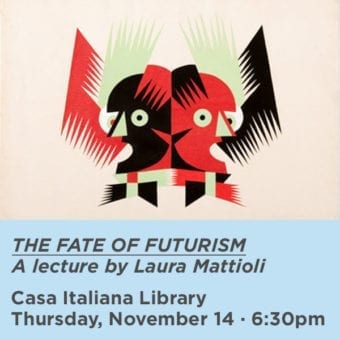
MEMBERS ONLY: PRIVATE TOUR OF “NEOREALISMO: THE NEW IMAGE IN ITALY”
November 14, 2018
CIMA Members are invited to join us for a private morning tour of NeoRealismo: The New Image in Italy 1932-1960 at the Grey Art Gallery, NYU. This exhibition portrays life in Italy through photography before, during, and after World War II. Installed thematically, NeoRealismo represents this pivotal moment of Italy’s cultural and social history with more than 170 images by over 60 Italian photographers. From ‘Realism in the Fascist Era’ through ‘Photojournalism and the Illustrated Press’ this exhibition traces how Italian photographers documented the immediate postwar period as well as Italy’s rebirth as a democratic nation.
Please note: CIMA Members will receive a private invitation link to RSVP for this event.
Enjoy free entry for tours and programs, exhibition access outside of public hours, the annual catalogue, and special members-only invitations
Want to learn more about photography in Italy? Check out the talk Lindsay Harris gave at CIMA in 2015 on Medardo Rosso and Photography in Turn-of-the-Century Italy!
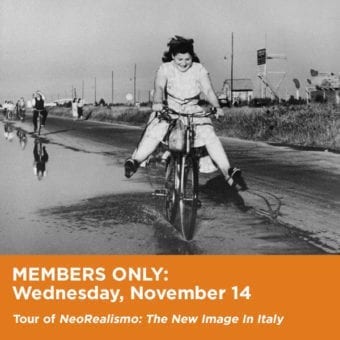
Metaphysical Years Lecture Series, Year 1: Franco Baldasso on 1916
November 13, 2018
Metaphysical Years Lecture Series
Year 1: Franco Baldasso on 1916
This chronological lecture series offers an overview of the birth and development of pittura metafisica (metaphysical art) against the backdrop of World War I as well as in the context of the post-war years in Italy. The presentations explore significant literary trends of the time along with socio-cultural events of the short yet crucially important period covered by CIMA’s 2018-19 exhibition, Metaphysical Masterpieces 1916-1920: Morandi, Sironi, and Carrà.
Italy entered World War I in 1915, on the side of Great Britain and France against what nationalist propaganda depicted as the “barbaric” central powers of Austria and Germany. While vanguard intellectuals portrayed the event as a matter of saving civilization, it was also an opportunity for Italy to affirm its role as a new power on the European stage. After the initial patriotic frenzy and collective enthusiasm that characterized Italy’s entrance into the conflict, 1916 proved to be a dramatic contrast: instead of experiencing an efficient, technological war—eulogized by the Marinetti and the Futurists as “only hygiene of the world”—Italian soldiers endured utterly exhausting and draining conditions in the trenches. Senseless, repeated massacres on the battlefields revealed a reality contrary to any idealized vision, one in which there was very little room for glory or individual heroism. Indeed, 1916 was indisputably the year of great Italian disillusion; like so many others that year, two of the most prominent Futurist artists, Umberto Boccioni and Antonio Sant’Elia, lost their lives while serving their country. Yet 1916 was also the year in which Italian poets, artists, and writers forged a new sense of humanity, a most profound communality and fraternity. This first evening in the Metaphysical Years Lecture Series will shed light on this crucial transitional moment in Italian art and history through selected readings of outstanding texts by authors such as Giuseppe Ungaretti and Curzio Malaparte as well as the presentation of original photographic material, never before seen in the United States, from the Archivio della Grande Guerra di Vittorio Veneto.
Franco Baldasso is Director of the Italian Program at Bard College, NY, where he is Assistant Professor of Italian Studies. In his research, Baldasso examines the complex relations between Fascism and Modernism, the legacy of political violence in Italy, and finally the idea of the Mediterranean in modern and contemporary aesthetics. He authored a book on Holocaust survivor Primo Levi, Il cerchio di gesso. Primo Levi narratore e testimone (Pendragon, 2007), co-edited an issue of Nemla-Italian Studies (“Italy in WWII and the Transition to Democracy: Memory, Fiction, Histories”) and contributes to publicbooks.org. Baldasso is a member of the Advisory Board of the Italian journal Allegoria, as well as the scientific committee of the Archivio della Memoria della Grande Guerra of the Centro Studi sulla Grande Guerra “P. Pieri” in Vittorio Veneto (TV). In summer 2017, he held a CIMA Affiliated Fellowship at the Civitella Ranieri Foundation for his forthcoming book, Against Redemption: Literary Dissent during the Transition to Post-Fascism in Italy.
Missed the program? Watch the video here.
Program schedule:
6pm – registration and viewing of Metaphysical Masterpieces
6:15pm – program begins, followed by audience Q&A
8pm – Evening concludes
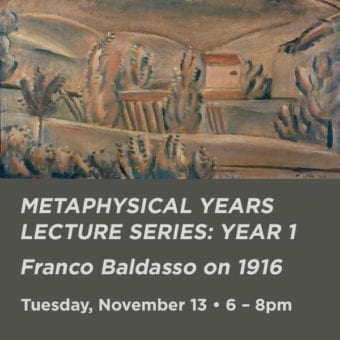
Mario Sironi and Margherita Sarfatti: Between avant-garde and modern classicism
November 08, 2018
CIMA is pleased to present an evening with art historian Rachele Ferrario on the incredible relationship between artist and critic Mario Sironi—one of the protagonists of the 2018-2019 exhibition Metaphysical Masterpieces—and Margherita Sarfatti, the well-known art patron, journalist, and founder of the Novecento group.
Both Sironi and Sarfatti held pivotal roles in shaping the history of Italian modern art, particularly in the short period that marks the crucial passage from Futurism to metaphysical art, and eventually to the so-called “Return to Order” at the beginning of the 1920s. After initially meeting in Milan during the first half of the 1910s, while Sironi was still engaged in the futurist movement, their friendship deepened in 1916, the unstable year of Umberto Boccioni’s death during World War I. From this moment on, this pair moved in parallel paths, working towards their shared goal of promoting Italian art both nationally and internationally, despite the considerable constraints placed on those years by the fascist regime.
As demonstrated by their prolific correspondence, Sironi was Sarfatti’s most important artistic interlocutor in years 1919 to 1926. Their letters shed light on their deep connection and demonstrate the ways in which Sironi inspired Sarfatti’s writings and ideas, particularly those concerning the birth of the Novecento movement. At the same time, the archive also serves as a testament to the influence Sarfatti had on Sironi’s artistic practice.
Later on in the 1950s, Margherita Sarfatti described Sironi’s talent to her friend Bernard Berenson as follows: “He is able to depict a human feeling just painting a pile of barrels or a bicycle: and that’s art!” Join us for this special night dedicated to this unique and important friendship.
Art historian and critic Rachele Ferrario teaches at the Accademia di Brera, Milan. She publishes regularly in the Corriere della Sera and has written several books, including Margherita Sarfatti: La regina dell’arte nell’Italia Fascista (2015 and 2018); La regina di quadri, the first biography of Palma Bucarelli (2010 and 2018), which has been just rereleased with a new preface; Le signore dell’arte (2012), a group portrait of Carol Rama, Carla Accardi, Giosetta Fioroni and Marisa Merz; and Les Italiens de Paris, sette artisti alla conquista di Parigi (2017).
Missed the program? Watch the video here.
Please note: CIMA will be live-streaming the program on our Facebook page.
Program schedule:
6pm: Viewing of Metaphysical Masterpieces
6:15pm: Program begins, followed by audience Q&A
8pm: Evening concludes

The 2018 Bridge Book Award
November 01, 2018
CIMA is proud to host an evening celebrating the fourth edition of The Bridge Book Award, honoring 2018 Italian winners Luciano Funetta, for fiction, and Sandra Petrignani, for non-fiction. Maria Ida Gaeta, director of the Casa delle Letterature, Ann Goldstein, a former editor of The New Yorker magazine, and Tiziana Rinaldi Castro, Italian novelist and journalist, will facilitate the discussion. Excerpts from the winning books will be read by Montclair State University students Oscar Guevara-Perez and Domenica Russo, who translated them under the guidance of Teresa Fiore (Inserra Chair, MSU). The program will be chaired by the Consul General of Italy in New York, Francesco Genuardi.
The Bridge Book Award was created by the Casa delle Letterature of the Municipality of Rome, the American Initiative for Italian Culture (AIFIC), and the U.S. Embassy in Rome. It is designed to be a “bridge” that connects the cultures of Italy and America and promotes knowledge of the most recent literary trends in the two countries. The award is conferred annually on one work of Fiction and one work of Non-Fiction. Winners receive the translation of their texts into the opposite language. This IV edition has been sustained by additional institutions including the Center for the Book and for Reading of the Ministry of Cultural Heritage (Centro per il libro e la lettura; CEPELL), in collaboration with the Federation of Italian Writers (Federazione Unitaria Italiana Scrittori; FUIS), the Italian Consulate in NYC, the American Academy in Rome, the Center for Fiction in NY, and the Civitella Ranieri Foundation.
The 2018 American winners are Lesley N. Arimah for fiction (What It Means When a Man Falls from the Sky, Riverhead Books) and Arielle Saiber for non-fiction (Measured Words: Computation and Writing in Renaissance Italy, University of Toronto Press). The award ceremony for the American writers will take place at Museum of Contemporary Art of Rome (Macro) on November 14.
Missed the program? Watch the video here.
Program schedule:
6pm – registration and exhibition viewing
6:15pm – conversation program begins, followed by Q&A
8pm – evening concludes
Speaker biographies:
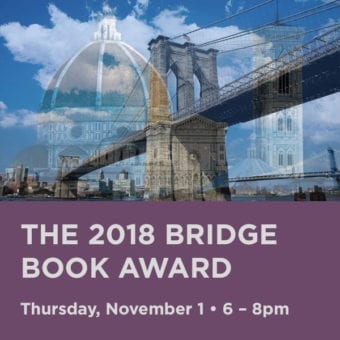
MEMBERS ONLY: NEOREALISMO—GALLERY EXHIBITIONS TOUR
October 24, 2018
CIMA Members are invited to join us for a private morning visit of two exhibitions of Italian postwar photography: The New Beginning for Italian Photography: 1945-1965 at Howard Greenberg Gallery and Neorealismo. Nuova Fotografia Italiana at Keith de Lellis. Featuring works by Carlo Bavagnoli, Mario de Biasi, Alfredo Camisa, and a host of others, these group exhibitions pay homage to the important role of the photographic medium for the development of the Neorealist movement.In addition to these shows, other important installations of neorealismo are currently on view at the Metropolitan Museum of Art and at the Grey Art Gallery; mark your calendars now for November 14th, when CIMA will host a members only private tour of the latter!
Enjoy free entry for tours and programs, exhibition access outside of public hours, the annual catalogue, and special members-only invitations
Want to learn more about photography in Italy? Check out the talk Lindsay Harris gave at CIMA in 2015 on Medardo Rosso and Photography in Turn-of-the-Century Italy!
Please note: CIMA Members will receive a private invitation link to RSVP for this event.
Members receive free admission to CIMA, access outside of regular public hours, a copy of the annual catalogue, and invitations to exclusive events and receptions.
